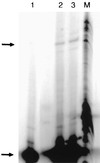Emergence of a dual-catalytic RNA with metal-specific cleavage and ligase activities: the spandrels of RNA evolution
- PMID: 9874791
- PMCID: PMC15112
- DOI: 10.1073/pnas.96.1.173
Emergence of a dual-catalytic RNA with metal-specific cleavage and ligase activities: the spandrels of RNA evolution
Abstract
In vitro selection, or directed molecular evolution, allows the isolation and amplification of rare sequences that satisfy a functional-selection criterion. This technique can be used to isolate novel ribozymes (RNA enzymes) from large pools of random sequences. We used in vitro evolution to select a ribozyme that catalyzes a novel template-directed RNA ligation that requires surprisingly few nucleotides for catalytic activity. With the exception of two nucleotides, most of the ribozyme contributes to a template, suggesting that it is a general prebiotic ligase. More surprisingly, the catalytic core built from randomized sequences actually contains a 7-nt manganese-dependent self-cleavage motif originally discovered in the Tetrahymena group I intron. Further experiments revealed that we have selected a dual-catalytic RNA from random sequences: the RNA promotes both cleavage at one site and ligation at another site, suggesting two conformations surrounding at least one divalent metal ion-binding site. Together, these results imply that similar catalytic RNA motifs can arise under fairly simple conditions and that multiple catalytic structures, including bifunctional ligases, can evolve from very small preexisting parts. By breaking apart and joining different RNA strands, such ribozymes could have led to the production of longer and more complex RNA polymers in prebiotic evolution.
Figures







Similar articles
-
A complex ligase ribozyme evolved in vitro from a group I ribozyme domain.Proc Natl Acad Sci U S A. 1999 Dec 21;96(26):14712-7. doi: 10.1073/pnas.96.26.14712. Proc Natl Acad Sci U S A. 1999. PMID: 10611278 Free PMC article.
-
Expanded divalent metal-ion tolerance of evolved ligase ribozymes.Biochimie. 2003 Jul;85(7):683-9. doi: 10.1016/s0300-9084(03)00127-5. Biochimie. 2003. PMID: 14505824
-
Divalent metal ion binding to a conserved wobble pair defining the upstream site of cleavage of group I self-splicing introns.Nucleic Acids Res. 1995 Feb 11;23(3):341-50. doi: 10.1093/nar/23.3.341. Nucleic Acids Res. 1995. PMID: 7885828 Free PMC article.
-
Directed evolution of nucleic acid enzymes.Annu Rev Biochem. 2004;73:791-836. doi: 10.1146/annurev.biochem.73.011303.073717. Annu Rev Biochem. 2004. PMID: 15189159 Review.
-
Evolution in an RNA world.Cold Spring Harb Symp Quant Biol. 2009;74:17-23. doi: 10.1101/sqb.2009.74.004. Epub 2009 Aug 10. Cold Spring Harb Symp Quant Biol. 2009. PMID: 19667013 Free PMC article. Review.
Cited by
-
Structure-guided engineering of the regioselectivity of RNA ligase ribozymes.J Am Chem Soc. 2009 Mar 18;131(10):3532-40. doi: 10.1021/ja8067325. J Am Chem Soc. 2009. PMID: 19220054 Free PMC article.
-
Tailoring RNA modular units on a common scaffold: a modular ribozyme with a catalytic unit for beta-nicotinamide mononucleotide-activated RNA ligation.RNA. 2009 May;15(5):877-88. doi: 10.1261/rna.1461309. Epub 2009 Mar 23. RNA. 2009. PMID: 19307294 Free PMC article.
-
Mapping L1 ligase ribozyme conformational switch.J Mol Biol. 2012 Oct 12;423(1):106-22. doi: 10.1016/j.jmb.2012.06.035. Epub 2012 Jul 3. J Mol Biol. 2012. PMID: 22771572 Free PMC article.
-
The effect of cytidine on the structure and function of an RNA ligase ribozyme.RNA. 2001 Mar;7(3):395-404. doi: 10.1017/s135583820100228x. RNA. 2001. PMID: 11333020 Free PMC article.
-
The origin of modern terrestrial life.HFSP J. 2007 Sep;1(3):156-68. doi: 10.2976/1.2759103. Epub 2007 Jul 25. HFSP J. 2007. PMID: 19404443 Free PMC article.
References
-
- Bartel D P, Szostak J W. Science. 1993;261:1411–1418. - PubMed
-
- Green R, Ellington A D, Szostak J W. Nature (London) 1990;347:406–408. - PubMed
-
- Beaudry A A, Joyce G F. Science. 1992;257:635–641. - PubMed
-
- Lehman N, Joyce J F. Nature (London) 1993;361:182–185. - PubMed
-
- Piccirilli J A, McConnell T S, Zaug A J, Noller H F, Cech T R. Science. 1992;256:1420–1424. - PubMed
Publication types
MeSH terms
Substances
LinkOut - more resources
Full Text Sources
Research Materials

